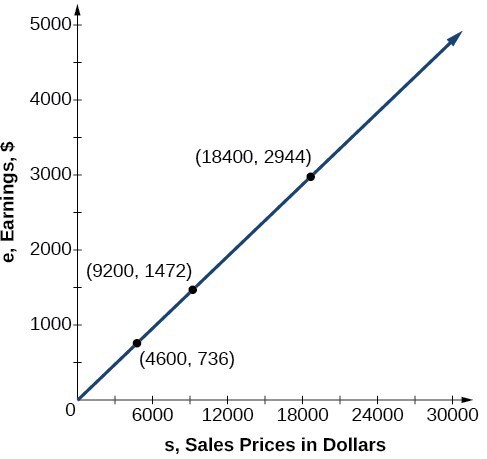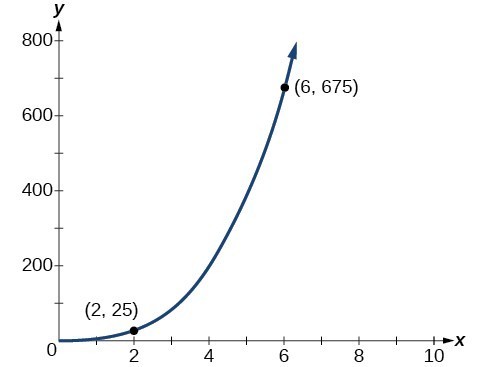Direct Variation
Learning Objectives
- Solve a direct variation problem
- Use a constant of variation to describe the relationship between two variables
| s, sales prices | e = 0.16s | Interpretation |
|---|---|---|
| $4,600 | e = 0.16(4,600) = 736 | A sale of a $4,600 vehicle results in $736 earnings. |
| $9,200 | e = 0.16(9,200) = 1,472 | A sale of a $9,200 vehicle results in $1472 earnings. |
| $18,400 | e = 0.16(18,400) = 2,944 | A sale of a $18,400 vehicle results in $2944 earnings. |

A General Note: Direct Variation
If x and y are related by an equation of the form[latex]y=k{x}^{n}[/latex]
then we say that the relationship is direct variation and y varies directly with the nth power of x. In direct variation relationships, there is a nonzero constant ratio [latex]k=\frac{y}{{x}^{n}}[/latex], where k is called the constant of variation, which help defines the relationship between the variables.How To: Given a description of a direct variation problem, solve for an unknown.
- Identify the input, x, and the output, y.
- Determine the constant of variation. You may need to divide y by the specified power of x to determine the constant of variation.
- Use the constant of variation to write an equation for the relationship.
- Substitute known values into the equation to find the unknown.
Example: Solving a Direct Variation Problem
The quantity y varies directly with the cube of x. If y = 25 when x = 2, find y when x is 6.Answer: The general formula for direct variation with a cube is [latex]y=k{x}^{3}[/latex]. The constant can be found by dividing y by the cube of x.
[latex]\begin{array}{l} k=\frac{y}{{x}^{3}} \\ =\frac{25}{{2}^{3}}\\ =\frac{25}{8}\end{array}[/latex]
Now use the constant to write an equation that represents this relationship.[latex]y=\frac{25}{8}{x}^{3}[/latex]
Substitute x = 6 and solve for y.[latex]\begin{array}{l}y=\frac{25}{8}{\left(6\right)}^{3}\hfill \\ \text{ }=675\hfill \end{array}[/latex]
Analysis of the Solution
The graph of this equation is a simple cubic, as shown below.
Q & A
Do the graphs of all direct variation equations look like Example 1? No. Direct variation equations are power functions—they may be linear, quadratic, cubic, quartic, radical, etc. But all of the graphs pass through (0, 0).Try It
The quantity y varies directly with the square of x. If y = 24 when x = 3, find y when x is 4.Answer: [latex]\frac{128}{3}[/latex]
Licenses & Attributions
CC licensed content, Original
- Revision and Adaptation. Provided by: Lumen Learning License: CC BY: Attribution.
CC licensed content, Shared previously
- Question ID 91391. Authored by: Jenck, Michael. License: CC BY: Attribution. License terms: IMathAS Community License CC-BY + GPL.
- College Algebra. Provided by: OpenStax Authored by: Abramson, Jay et al.. Located at: https://openstax.org/books/college-algebra/pages/1-introduction-to-prerequisites. License: CC BY: Attribution. License terms: Download for free at http://cnx.org/contents/[email protected].
- Direct Variation Applications . Authored by: James Sousa (Mathispower4u.com) . License: CC BY: Attribution.

